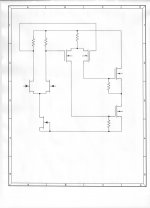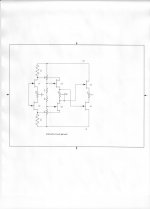No claims made other than output current, bias, etc. diy'ers feel good about doing it themselves i.e. fun.
Also, DIYers can close an internal feedback loop, before the buffer, and compare results.
I will check back in a year or so... maybe by then ONE design will finally emerge...
nah.
but let's assume that "we" arrive at say 6-12 topologies reduced to practical design (seems like this is more likely than a single design agreement?), now what?
Do they get sim'd and selected?
Criteria?
Or sim'd, say top 3-6 culled (based on those "criteria"?), and then some prototype builds followed by what? Actual tests for specs? Listening tests??
Or maybe that is enough?
Go to PCB group buys and see what people say?
We can burn the discrete through-hole vs. SMT vs. both bridge down the road...
Just looking ahead to see where this needs to go. No GPS here.
_-_-bear
nah.
but let's assume that "we" arrive at say 6-12 topologies reduced to practical design (seems like this is more likely than a single design agreement?), now what?
Do they get sim'd and selected?
Criteria?
Or sim'd, say top 3-6 culled (based on those "criteria"?), and then some prototype builds followed by what? Actual tests for specs? Listening tests??
Or maybe that is enough?
Go to PCB group buys and see what people say?
We can burn the discrete through-hole vs. SMT vs. both bridge down the road...
Just looking ahead to see where this needs to go. No GPS here.
_-_-bear
PMA's circuit looks like two CFA inputs looking at eachother, it lends itself very well to full differential connection.
[...]
Yes, but its a pity that with BJT you need lots of biasing stuff: I1, 2, 3, 4 and Q1, 6, 12, 13, wich you would not if P and N Channel JFET's were allowed.....
PMA's circuit looks like two CFA inputs looking at eachother, it lends itself very well to full differential connection.
For that matter that simplified 844 made with discrete duals could be tuned up nicely for several applications. I think there are cheap SMT dual's in the BXXXX series. That's 8 SOT6's and an output pair and you have access to all nodes so you play with Charles Hansen's ideas.
NXP and Diodes Inc. at one time at least made duals that were two isolated chips plucked from adjacent locations on the wafer, with usually not much by way of guarantees but likely pretty decent matching.
I once talked to Diodes about what the breakdown voltage was between the chips. The guy's first response was But they are isolated! There's no way you can have breakdown!
I said Oh good! So I can run them at 10 kilovolts difference in potential??
At that point he got it, and conceded that they had no idea
Then the next question - for those of us who must follow the opera by reading the libretto - references, papers and texts to stare at blankly in the vain hope of discovering only some of these complexities...
this is one I discovered in the first edition years back... I don't pretend to have digested it all by any means:
Bipolar and MOS Analog Integrated Circuit Design (Wiley Classics Library)
By: Alan B. Grebene
_-_-
PS. when I first saw this book, I thought to myself - "myself, how the heck did this guy learn all of this, when all the other texts I have seen don't even scratch this surface at all??" (ie. where are they keeping the real information hidden? Do you have to reinvent the wheel for yourself?)
this is one I discovered in the first edition years back... I don't pretend to have digested it all by any means:
Bipolar and MOS Analog Integrated Circuit Design (Wiley Classics Library)
By: Alan B. Grebene
_-_-
PS. when I first saw this book, I thought to myself - "myself, how the heck did this guy learn all of this, when all the other texts I have seen don't even scratch this surface at all??" (ie. where are they keeping the real information hidden? Do you have to reinvent the wheel for yourself?)
Last edited:
john curl,
Your so practical, and this discussion doesn't seem to have anything to do with practicality. I guess we can just reinvent the wheel until we get a square one and then decide that it won't go around any better than what exist, but that seems to be the point of this project. Just to try something and see what happens.
Your so practical, and this discussion doesn't seem to have anything to do with practicality. I guess we can just reinvent the wheel until we get a square one and then decide that it won't go around any better than what exist, but that seems to be the point of this project. Just to try something and see what happens.
NXP and Diodes Inc. at one time at least made duals that were two isolated chips plucked from adjacent locations on the wafer, with usually not much by way of guarantees but likely pretty decent matching.
I once talked to Diodes about what the breakdown voltage was between the chips. The guy's first response was But they are isolated! There's no way you can have breakdown!
I said Oh good! So I can run them at 10 kilovolts difference in potential??
At that point he got it, and conceded that they had no idea
70 volts per mil of physical isolation if it is a hermetically sealed hybrid. I assume they enclosed dry nitrogen during lid one shot weld..
jn
Kindhornman, unless you are capable of "holding court" here, then perhaps it is best to sit back and maybe learn something about the subtleties of IC and discrete opamp engineering, design and analysis? Even if *nothing new* comes forth, there is a lot of information that is likely to flow - stuff that unless you were in an engineering group at one of the companies that make this stuff you and I are not likely to be privy to, ever.
Just a thought.
_-_-bear
Just a thought.
_-_-bear
These were in plastic SMD of some sort. I'll try to find them. In fact, now that I think of it I specified them in a client's ten pounds in a five pound product, which, as I realized was their custom, never got completed. Although after making a plethora of errors, the layout guy said Why fix those if we don't know that it works, and another person at the company suggested I do all the troubleshooting of the flawed boards for free70 volts per mil of physical isolation if it is a hermetically sealed hybrid. I assume they enclosed dry nitrogen during lid one shot weld..
jn
NXP and Diodes Inc. at one time at least made duals that were two isolated chips plucked from adjacent locations on the wafer, with usually not much by way of guarantees but likely pretty decent matching.
Do they still make the LM 194/294/394?
Is the PMI SSM2210 still being made?
jn
These were in plastic SMD of some sort. I'll try to find them.
Ah, thanks.
Encapsulation compound dielectric strength is less than 425 volts per mil, I'd never go over 250 volts/mil. Externally, I'd stay under 25.
jn
John;
the second stage is loaded on very different resistances: one to ground, another bootstrapped. One output device works with common source, another with common drain. As the result, highly modulated current through output devices and awful distortions, starting from the 2'nd order. Extremely poor thermal stability, both of output voltage and idle current.
the second stage is loaded on very different resistances: one to ground, another bootstrapped. One output device works with common source, another with common drain. As the result, highly modulated current through output devices and awful distortions, starting from the 2'nd order. Extremely poor thermal stability, both of output voltage and idle current.
Both the "first edition" which actually had a different title and the one you mention are great books. Why not seen elsewhere? Well, some of the disclosed things were proprietary. IC manufacturers have to make money and if possible retain a competitive edge.Then the next question - for those of us who must follow the opera by reading the libretto - references, papers and texts to stare at blankly in the vain hope of discovering only some of these complexities...
this is one I discovered in the first edition years back... I don't pretend to have digested it all by any means:
Bipolar and MOS Analog Integrated Circuit Design (Wiley Classics Library)
By: Alan B. Grebene
_-_-
PS. when I first saw this book, I thought to myself - "myself, how the heck did this guy learn all of this, when all the other texts I have seen don't even scratch this surface at all??" (ie. where are they keeping the real information hidden? Do you have to reinvent the wheel for yourself?)
One such part: DMMT3906W, in SOT-363: http://www.diodes.com/datasheets/ds30312.pdfAh, thanks.
Encapsulation compound dielectric strength is less than 425 volts per mil, I'd never go over 250 volts/mil. Externally, I'd stay under 25.
jn
I see there are some matching specs.
Brad
Brad, sorry I should have said "that I had not seen elsewhere...". Doesn't mean that this stuff was not out there, just that sitting in relative isolation, I had not found it via various pseudo random efforts to locate this sort of information - this was before the internet as we know it today... that meant trips to various university libraries and bookstores - many of the texts were even back then in the >$100 range, which was daunting. I persuaded someone to make me a photocopy of Grebene, because I couldn't swing the bux for even a used copy... whaaaaa! 
_-_-bear
_-_-bear
- Home
- Source & Line
- Analog Line Level
- Discrete Opamp Open Design

